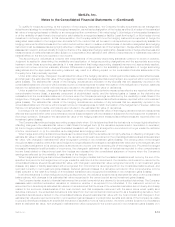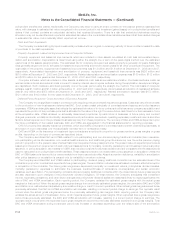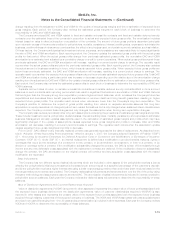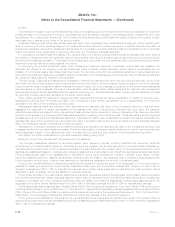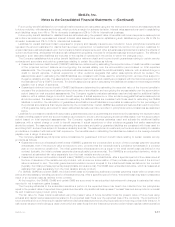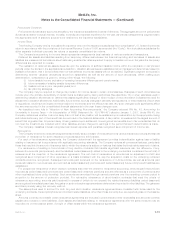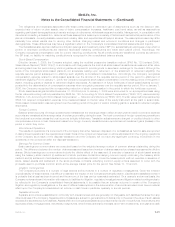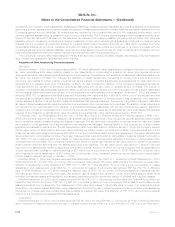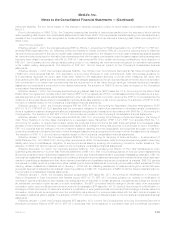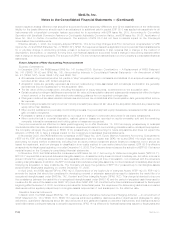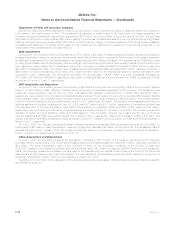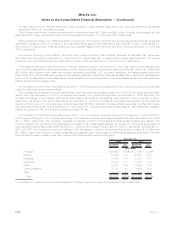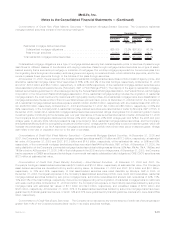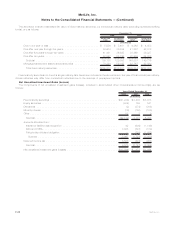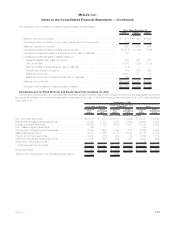MetLife 2008 Annual Report Download - page 146
Download and view the complete annual report
Please find page 146 of the 2008 MetLife annual report below. You can navigate through the pages in the report by either clicking on the pages listed below, or by using the keyword search tool below to find specific information within the annual report.requires additional qualitative and quantitative disclosures about a transferors’ continuing involvement in transferred financial assets and
involvement in VIE. The exact nature of the additional required VIE disclosures vary and depend on whether or not the VIE is a qualifying
special-purpose entity (“QSPE”). For VIEs that are QSPEs, the additional disclosures are only required for a non-transferor sponsor holding
a variable interest or a non-transferor servicer holding a significant variable interest. For VIEs that are not QSPEs, the additional disclosures
are only required if the Company is the primary beneficiary, and if not the primary beneficiary, only if the Company holds a significant
variable interest or is the sponsor. The Company provided all of the material required disclosures in its consolidated financial statements.
Effective December 31, 2008, the Company adopted FSP No. EITF 99-20-1, Amendments to the Impairment Guidance of EITF Issue
No. 99-20 (“FSP EITF 99-20-1”). FSP EITF 99-20-1 amends the guidance in EITF Issue No. 99-20, Recognition of Interest Income and
Impairment on Purchased Beneficial Interests and Beneficial Interests That Continue to Be Held by a Transferor in Securitized Financial
Assets, to more closely align the guidance to determine whether an other-than-temporary impairment has occurred for a beneficial interest
in a securitized financial asset with the guidance in SFAS 115 for debt securities classified as available-for-sale or held-to-maturity. The
adoption of FSP EITF 99-20-1 did not have an impact on the Company’s consolidated financial statements.
Derivative Financial Instruments
Effective December 31, 2008, the Company adopted FSP No. FAS 133-1 and FIN 45-4, Disclosures about Credit Derivatives and
Certain Guarantees — An Amendment of FASB Statement No. 133 and FASB Interpretation No. 45; and Clarification of the Effective Date
of FASB Statement No. 161 (“FSP 133-1 and FIN 45-4”). FSP 133-1 and FIN 45-4 amends SFAS No. 133, Accounting for Derivative
Instruments and Hedging Activities (“SFAS 133”) to require certain enhanced disclosures by sellers of credit derivatives by requiring
additional information about the potential adverse effects of changes in their credit risk, financial performance, and cash flows. It also
amends FIN No. 45, Guarantor’s Accounting and Disclosure Requirements for Guarantees, Including Indirect Guarantees of Indebtedness
of Others — An Interpretation of FASB Statements No. 5, 57, and 107 and Rescission of FASB Interpretation No. 34 (“FIN 45”), to require
an additional disclosure about the current status of the payment/performance risk of a guarantee. The Company provided all of the material
required disclosures in its consolidated financial statements.
Effective January 1, 2008, the Company adopted SFAS 133 Implementation Issue No. E-23, Clarification of the Application of the
Shortcut Method (“Issue E-23”). Issue E-23 amended SFAS 133 by permitting interest rate swaps to have a non-zero fair value at inception
when applying the shortcut method of assessing hedge effectiveness, as long as the difference between the transaction price (zero) and
the fair value (exit price), as defined by SFAS 157, is solely attributable to a bid-ask spread. In addition, entities are not precluded from
applying the shortcut method of assessing hedge effectiveness in a hedging relationship of interest rate risk involving an interest bearing
asset or liability in situations where the hedged item is not recognized for accounting purposes until settlement date as long as the period
between trade date and settlement date of the hedged item is consistent with generally established conventions in the marketplace. The
adoption of Issue E-23 did not have an impact on the Company’s consolidated financial statements.
Effective January 1, 2006, the Company adopted prospectively SFAS No. 155, Accounting for Certain Hybrid Instruments (“SFAS 155”).
SFAS 155 amends SFAS 133 and SFAS No. 140, Accounting for Transfers and Servicing of Financial Assets and Extinguishments of
Liabilities (“SFAS 140”). SFAS 155 allows financial instruments that have embedded derivatives to be accounted for as a whole, eliminating
the need to bifurcate the derivative from its host, if the holder elects to account for the whole instrument on a fair value basis. In addition,
among other changes, SFAS 155:
(i) clarifies which interest-only strips and principal-only strips are not subject to the requirements of SFAS 133;
(ii) establishes a requirement to evaluate interests in securitized financial assets to identify interests that are freestanding
derivatives or that are hybrid financial instruments that contain an embedded derivative requiring bifurcation;
(iii) clarifies that concentrations of credit risk in the form of subordination are not embedded derivatives; and
(iv) amends SFAS 140 to eliminate the prohibition on a QSPE from holding a derivative financial instrument that pertains to a
beneficial interest other than another derivative financial interest.
The adoption of SFAS 155 did not have a material impact on the Company’s consolidated financial statements.
Effective October 1, 2006, the Company adopted SFAS 133 Implementation Issue No. B40, Embedded Derivatives: Application of
Paragraph 13(b) to Securitized Interests in Prepayable Financial Assets (“Issue B40”). Issue B40 clarifies that a securitized interest in
prepayable financial assets is not subject to the conditions in paragraph 13(b) of SFAS 133, if it meets both of the following criteria: (i) the
right to accelerate the settlement if the securitized interest cannot be controlled by the investor; and (ii) the securitized interest itself does
not contain an embedded derivative (including an interest rate-related derivative) for which bifurcation would be required other than an
embedded derivative that results solely from the embedded call options in the underlying financial assets. The adoption of Issue B40 did
not have a material impact on the Company’s consolidated financial statements.
Effective January 1, 2006, the Company adopted prospectively SFAS 133 Implementation Issue No. B38, Embedded Derivatives:
Evaluation of Net Settlement with Respect to the Settlement of a Debt Instrument through Exercise of an Embedded Put Option or Call
Option (“Issue B38”) and SFAS 133 Implementation Issue No. B39, Embedded Derivatives: Application of Paragraph 13(b) to Call Options
That Are Exercisable Only by the Debtor (“Issue B39”). Issue B38 clarifies that the potential settlement of a debtor’s obligation to a creditor
occurring upon exercise of a put or call option meets the net settlement criteria of SFAS 133. Issue B39 clarifies that an embedded call
option, in which the underlying is an interest rate or interest rate index, that can accelerate the settlement of a debt host financial instrument
should not be bifurcated and fair valued if the right to accelerate the settlement can be exercised only by the debtor (issuer/borrower) and
the investor will recover substantially all of its initial net investment. The adoption of Issues B38 and B39 did not have a material impact on
the Company’s consolidated financial statements.
Income Taxes
Effective January 1, 2007, the Company adopted FIN 48. FIN 48 clarifies the accounting for uncertainty in income tax recognized in a
company’s financial statements. FIN 48 requires companies to determine whether it is “more likely than not” that a tax position will be
sustained upon examination by the appropriate taxing authorities before any part of the benefit can be recorded in the financial statements.
F-23MetLife, Inc.
MetLife, Inc.
Notes to the Consolidated Financial Statements — (Continued)


